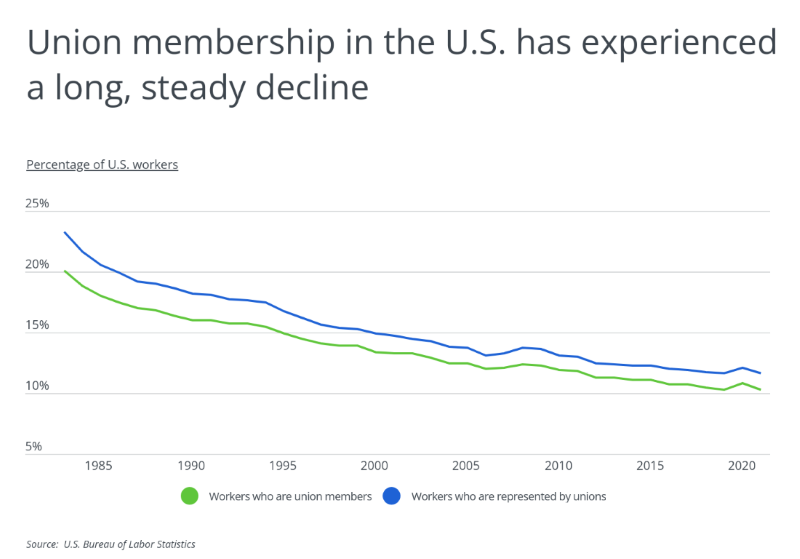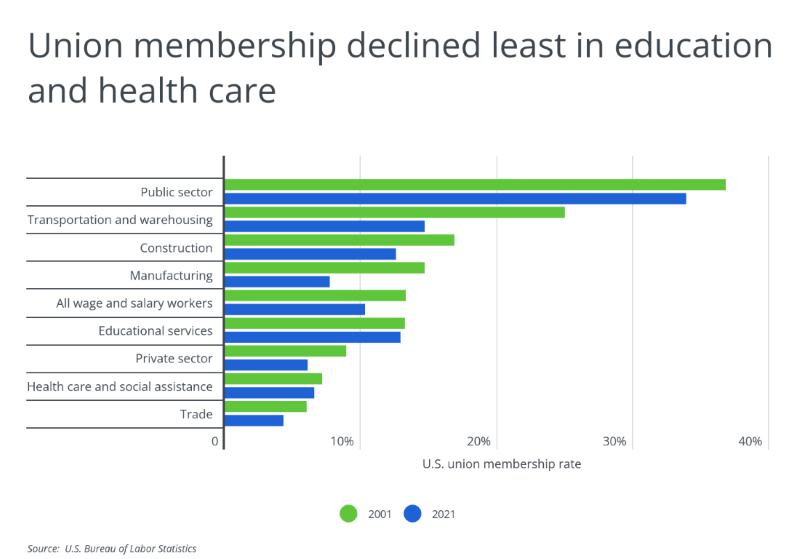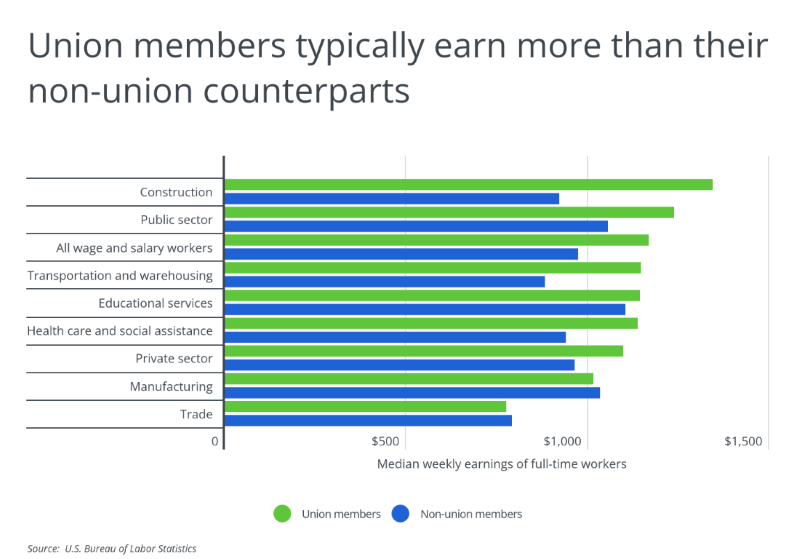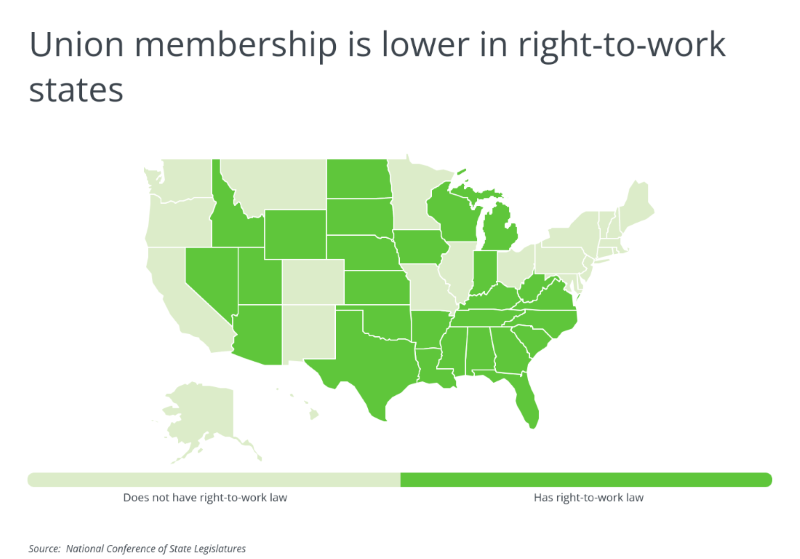States With the Highest Union Participation Rates
 Photo Credit: Ground Picture / Shutterstock
Photo Credit: Ground Picture / Shutterstock
July 13th, 2022
The U.S. economy today, in some ways, offers the most favorable conditions workers have had in years. The unemployment rate is as low as it has been in two decades, having bounced back from a COVID-induced spike in 2020. Simultaneously, the wave of departures and job switches now known as the Great Resignation suggests that workers are on the hunt for better jobs. To recruit and retain employees in a tight labor market, employers are raising wages and offering better benefits and flexible working arrangements.
Amid these labor-friendly conditions, another historic source of worker power may be making a comeback: unions.
Recent union drives at major U.S. employers like Starbucks and Amazon have grabbed headlines. Meanwhile, Congress is currently considering the PRO Act, a major piece of legislation that aims to strengthen unions. Support for unions is similarly widespread among the general population; a majority of Americans believe that declines in union membership have been bad for the country, and according to the National Labor Relations Board, petitions for union elections nationwide rose by 57% from 2021 to 2022.
While labor organizing appears to be on the rise again, unions have a ways to go to reverse the long-running decline of unionization in recent decades. Forty years ago, one in five U.S. workers (20.1%) was a union member, but today, that figure is approximately one in ten (10.3%).

Experts point to a number of factors for the decline of unions in the U.S. The rise of right-to-work laws beginning in the middle of the 20th century allowed more employers to hire non-union workers. The economic downturn of the late 1970s and early 1980s led to major layoffs for many heavily unionized employers and industries. Globalization has also made it easier for employers to find less expensive labor outside of the U.S., while technological advancements have allowed certain professions to be more automated.
Forty years ago, one in five U.S. workers (20.1%) was a union member, but today, that figure is approximately one in ten (10.3%).
The impact of these factors has been experienced differently across various sectors of the economy.
Industries like manufacturing, construction, trade, and transportation and warehousing have seen the sharpest declines in union membership rate over the last two decades. These are industries that have been reshaped by the major economic and social trends that contributed to decreases in union participation. In contrast, fields like education and health care have experienced more measured declines.

Unionization's steady decline has been statistically costly for workers in many industries. Across all wage and salary workers, union members receive $194 more per week than non-union members in median weekly earnings. In some cases, the difference is even greater: for example, union construction workers earn $422 more per week than their non-union categories.

As organized labor potentially regrows its role in the U.S. economy, some parts of the country may offer more favorable conditions than others. Among the 27 states with right-to-work laws, union membership rates average 6.1%, compared to 13.8% in the states without them.
… construction workers earn $422 more per week than their non-union categories.
Rates are even lower in some parts of the country, including Southern states which historically have had more limitations on union activity. By contrast, the top states for union participation are largely found in the Northeast and in the West.

The data used in this analysis is from the U.S. Bureau of Labor Statistics 2021 Current Population Survey. To determine the states with the highest union participation rates, researchers at HireAHelper calculated the percentage of workers who are union members. In the event of a tie, the state with the greater percentage of workers who are represented by unions was ranked higher.
Here are the states with the highest union participation rates.
States With the Highest Union Participation Rates
 Photo Credit: Sean Pavone / Shutterstock
Photo Credit: Sean Pavone / Shutterstock15. Maine
- Percentage of workers who are union members: 12.4%
- Percentage of workers who are represented by unions: 14.7%
- Total workers who are union members: 70,000
- Total workers who are represented by unions: 83,000
 Photo Credit: Sean Pavone / Shutterstock
Photo Credit: Sean Pavone / Shutterstock14. Massachusetts
- Percentage of workers who are union members: 12.6%
- Percentage of workers who are represented by unions: 13.6%
- Total workers who are union members: 402,000
- Total workers who are represented by unions: 433,000
 Photo Credit: Sean Pavone / Shutterstock
Photo Credit: Sean Pavone / Shutterstock13. Pennsylvania
- Percentage of workers who are union members: 12.9%
- Percentage of workers who are represented by unions: 13.6%
- Total workers who are union members: 693,000
- Total workers who are represented by unions: 732,000
 Photo Credit: Sean Pavone / Shutterstock
Photo Credit: Sean Pavone / Shutterstock12. Michigan
- Percentage of workers who are union members: 13.3%
- Percentage of workers who are represented by unions: 15.3%
- Total workers who are union members: 540,000
- Total workers who are represented by unions: 620,000
 Photo Credit: Sean Pavone / Shutterstock
Photo Credit: Sean Pavone / Shutterstock11. Illinois
- Percentage of workers who are union members: 13.9%
- Percentage of workers who are represented by unions: 15.2%
- Total workers who are union members: 752,000
- Total workers who are represented by unions: 818,000
 Photo Credit: Sean Pavone / Shutterstock
Photo Credit: Sean Pavone / Shutterstock10. Connecticut
- Percentage of workers who are union members: 14.6%
- Percentage of workers who are represented by unions: 16.3%
- Total workers who are union members: 223,000
- Total workers who are represented by unions: 248,000
 Photo Credit: Sean Pavone / Shutterstock
Photo Credit: Sean Pavone / Shutterstock9. Rhode Island
- Percentage of workers who are union members: 15.7%
- Percentage of workers who are represented by unions: 17.4%
- Total workers who are union members: 75,000
- Total workers who are represented by unions: 83,000
 Photo Credit: Marcus Biastock / Shutterstock
Photo Credit: Marcus Biastock / Shutterstock8. Alaska
- Percentage of workers who are union members: 15.8%
- Percentage of workers who are represented by unions: 17.2%
- Total workers who are union members: 46,000
- Total workers who are represented by unions: 50,000
 Photo Credit: Sean Pavone / Shutterstock
Photo Credit: Sean Pavone / Shutterstock7. California
- Percentage of workers who are union members: 15.9%
- Percentage of workers who are represented by unions: 17.8%
- Total workers who are union members: 2,468,000
- Total workers who are represented by unions: 2,757,000
 Photo Credit: Checubus / Shutterstock
Photo Credit: Checubus / Shutterstock6. Minnesota
- Percentage of workers who are union members: 16.0%
- Percentage of workers who are represented by unions: 17.1%
- Total workers who are union members: 416,000
- Total workers who are represented by unions: 446,000
 Photo Credit: Sean Pavone / Shutterstock
Photo Credit: Sean Pavone / Shutterstock5. New Jersey
- Percentage of workers who are union members: 16.2%
- Percentage of workers who are represented by unions: 17.9%
- Total workers who are union members: 608,000
- Total workers who are represented by unions: 672,000
 Photo Credit: Sean Pavone / Shutterstock
Photo Credit: Sean Pavone / Shutterstock4. Oregon
- Percentage of workers who are union members: 17.8%
- Percentage of workers who are represented by unions: 18.8%
- Total workers who are union members: 318,000
- Total workers who are represented by unions: 336,000
 Photo Credit: f11photo / Shutterstock
Photo Credit: f11photo / Shutterstock3. Washington
- Percentage of workers who are union members: 19.0%
- Percentage of workers who are represented by unions: 20.0%
- Total workers who are union members: 629,000
- Total workers who are represented by unions: 661,000
 Photo Credit: Andrew Zarivny / Shutterstock
Photo Credit: Andrew Zarivny / Shutterstock2. New York
- Percentage of workers who are union members: 22.2%
- Percentage of workers who are represented by unions: 24.1%
- Total workers who are union members: 1,729,000
- Total workers who are represented by unions: 1,869,000
 Photo Credit: Dave H. Fine / Shutterstock
Photo Credit: Dave H. Fine / Shutterstock1. Hawaii
- Percentage of workers who are union members: 22.4%
- Percentage of workers who are represented by unions: 24.1%
- Total workers who are union members: 121,000
- Total workers who are represented by unions: 131,000
Detailed Findings & Methodology
The data used in this analysis is from the U.S. Bureau of Labor Statistics 2021 Current Population Survey. To determine the states with the highest union participation rates, researchers calculated the percentage of workers who are union members. In the event of a tie, the state with the greater percentage of workers who are represented by unions was ranked higher. For clarification, “workers who are represented by unions” includes both union members who have the right to vote on union business, as well as workers who report no union affiliation but whose jobs are covered by a union contract.
Only the 100 largest metropolitan areas with available data were considered in this analysis.